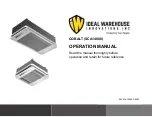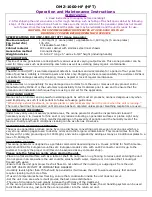
Cold-
Shot™
5
5.
While work is in progress, the flow of carbon di-
oxide refrigerant must be maintained
. To ensure a
sufficient supply of refrigerant is available, a stand-by
cylinder is suggested. The only way to determine the
amount of remaining carbon dioxide is to weigh the
cylinder. If it is necessary to change the cylinder dur-
ing work, it is essential that this procedure should be
completed within 7 minutes to prevent the ice pack
from melting.
6. Once work is complete, close the cylinder valve and
wait until the pressure in the spiral hoses has re-
turned to normal before removing them from the
valve. Once the ice pack
has completely melted
,
carefully unscrew and remove the injector at the end
of the spiral hoses from the freeze head, then re-
move the freeze head from the pipe.
ESTIMATED FREEZING TIMES
The freezing times and carbon dioxide requirements given in the table below are
only to be regarded as general
guidelines
and are valid for a water temperature of approximately 68
°
F (20
°
C). The freezing times and refrigerant con-
sumption values will therefore vary for other temperatures. For freezing liquids in plastic pipes, much longer freezing
times are generally required.
FREEZE HEAD SIZE
MATERIAL
FREEZING TIME
CARBON DIOXIDE
REQUIREMENT
NUMBER OF
FREEZING
OPERATIONS
POSSIBLE PER
20 LBS. (10KG)
CYLINDER PER
FREEZE HEAD
1/8” (10
- 12 mm)
Steel
Copper
1 min.
1 min.
2 oz (60 g)
2.25 oz (65 g)
165
160
1/4” (15 mm)
Steel
Copper
1 min.
2 min.
2.5 oz (75 g)
4.75 oz (135 g)
130
75
3/8” (18 mm)
Steel
Copper
2 min.
3 min.
5.25 oz (150 g)
7 oz (200 g)
65
50
1/2” (22 mm)
Steel
Copper
3 min.
5 min.
8 oz (225 g)
11.75 oz (330 g)
45
30
3/4” (28 mm)
Steel
Copper
5 min.
7 min.
12.25 oz (350 g)
15.75 oz (450 g)
29
22
1” (35 mm)
Steel
Copper
7 min.
10 min.
17.75 oz (500 g)
23 oz (650 g)
20
15
1-
1/4” (42 mm)
Steel
Copper
11 min.
14 min.
24.5 oz (700 g)
31.75 oz (900 g)
15
11
1-
1/2” (54 mm)
Steel
Copper
16 min.
24 min.
37 oz (1050 g)
51 oz (1450 g)
10
7
2” (60 mm)
Steel
29 min.
67 oz (1900 g)
5
3. After a brief period, frost will form on the pipe in the
vicinity of the freeze heads. (See Table) If frost does
not form in accordance with the time given in the ta-
ble, this indicates that the liquid within the pipe is still
flowing or the liquid is too warm. Make sure that all
pumps have been switched off and prevent any re-
moval or outflow of liquid.
4.
Test to insure you have a complete ice blockage
before starting repair.
To test, carefully and slightly
open a valve or loosen a fitting behind the desired
blockage. If leakage of liquid stops after a short while
(depending on liquid contents after the ice plug), the
blockage is operational. If not, close the valve or
tighten the fitting and continue freezing. Or, drill a
small hole between the ice plug and repair area. If
leakage stops after a short time (as mentioned
above), it is safe to proceed. If not, you can use a
hose or pipe clamp to stop further leakage, and con-
tinue the freezing process.
























